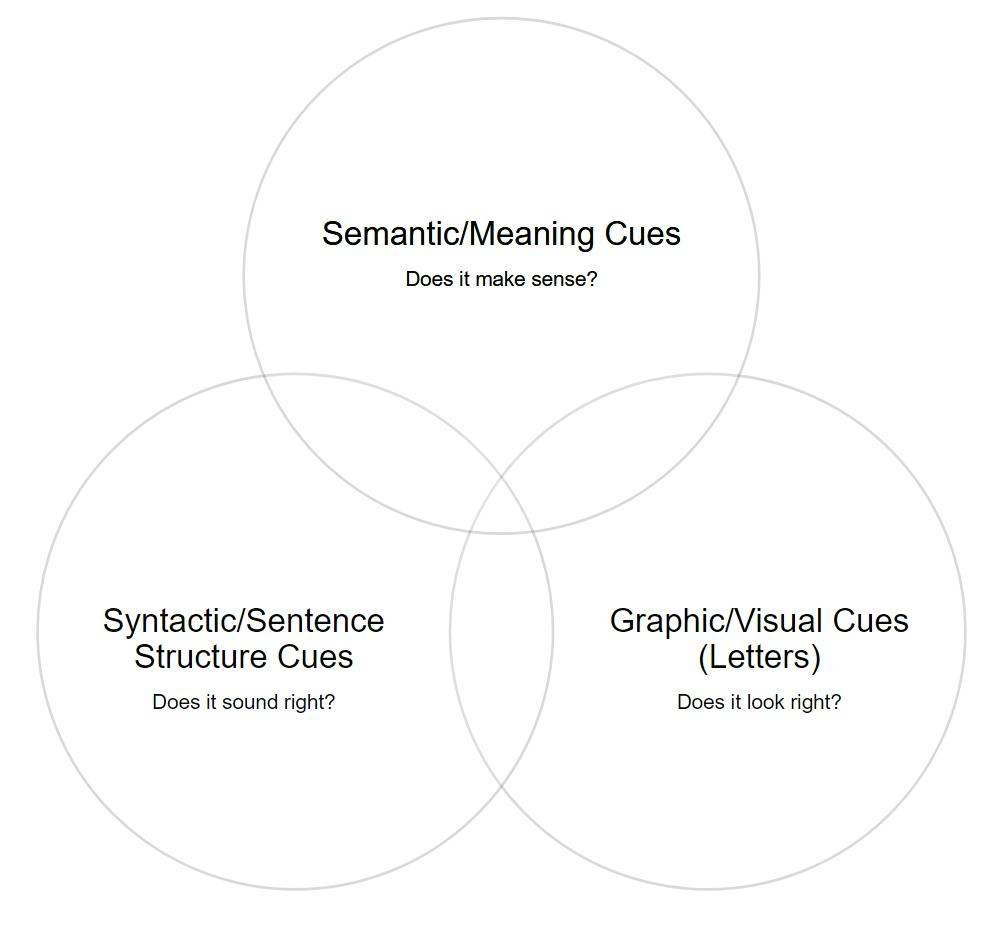[读书摘要] 学校的英文阅读教学错在哪里?--经验主义和认知科学的PK
Posted 幻灰龙
tags:
篇首语:本文由小常识网(cha138.com)小编为大家整理,主要介绍了[读书摘要] 学校的英文阅读教学错在哪里?--经验主义和认知科学的PK相关的知识,希望对你有一定的参考价值。
原文:https://www.apmreports.org/episode/2019/08/22/whats-wrong-how-schools-teach-reading
传统的阅读三部曲:记住单词、通过上下文猜单词、猜不出来跳过去
- memorizing words
- using context to guess words
- skipping words they don't know
Ken Goodman 在1967 提出 three cueing 理论:图形、语法、语义:
- graphic cues (what do the letters tell you about what the word might be?)
- syntactic cues (what kind of word could it be, for example, a noun or a verb?)
- semantic cues (what word would make sense here, based on the context?)
前者关注单词,后者关注图式、结构和语义。(注:这并不是本文对比的重点,往下看,和认知科学的实验的PK才是重点)
Skill in reading involves not greater precision, but more accurate first guesses based on better sampling techniques, greater control over language structure, broadened experiences and increased conceptual development. As the child develops reading skill and speed, he uses increasingly fewer graphic cues.
可以再追溯到1960年Marie Clay提出的MSV模式:
- M stands for using meaning to figure out what a word is
- S for using sentence structure and
- V for using visual information (i.e., the letters in the words)
如果听错一个单词的时候,我们常见的做法是反复再听,但是教师可能会采用转移注意力的方式,让学生关注单词代表的是什么意思:
For example, a child who says "horse" when the word was "house" is probably relying too much on visual, or graphic, cues. A teacher in this case would encourage the child to pay more attention to what word would make sense in the sentence.
Goodman 和 Clay 认为单词本身对上述三个提示的作用最低,因此要成为一个好的阅读者,不必关注所有的单词。有效阅读应该关注句子的含义和内容,再和单词的形式联系起来。
80年代Goodman的理论更多的以 "whole language" 的形式被传播。
与此同时,认知科学家们开始研究阅读中单词的信息处理问题。Keith Stanovich 从1970年开始研究这个问题,他知道Goodman的理论,并且猜测这个理论是对的。
1975年,Stanovich 招募人员做一系列的阅读任务的实验,他们假设有经验的阅读者相对于低水平阅读者会更多地使用上下文来猜测单词的含义。实验结果出乎意料,低水平的阅读者反而会更多的依赖上下文来猜测单词的意思。高水平的阅读者几乎可以立即猜测单词的意思。其他研究者的实验验证了这些结论。
也就是说,是否能独立快速的识别单词,是阅读水平的关键。
It turns out that the ability to read words in isolation quickly and accurately is the hallmark of being a skilled reader.
其他一些相关研究,继续发现了Three Cue Reading的问题:
-
高水平的阅读者,能快速立刻识别单词。因此他们可以直接识别出"house"和"horse"的区别。Skilled readers don't scan words and sample from the graphic cues in an incidental way; instead, they very quickly recognize a word as a sequence of letters. That's how good readers instantly know the difference between "house" and "horse," for example.
-
如果强制让高水平阅读者根据上下文猜测单词含义,猜测正确的比例和低水平阅读者没没有太大区别。Experiments that force people to use context to predict words show that even skilled readers can correctly guess only a fraction of the words; this is one reason people who rely on context to identify words are poor readers.
-
阅读障碍的核心问题还是对单词识别的强弱。Weak word recognition skills are the most common and debilitating source of reading problems.16
认知科学的实验,挑战了图、视频、等环境提示进阶阅读的理论。他们认为这种方式的阅读是错误的。
Goldberg在2015年设计了一套不同的阅读训练程序SIPPS:
"Systematic Instruction in Phonological Awareness, Phonics, and Sight Words,"
这是一套Phonics(语音/拼读)系统,被设计来“解构书本”,每个单词都有一定的拼读模式,学生们被分成两部分,一部分用拼读训练程序,一部分继续采用three cueing 方式。改变的不是他们的阅读能力,而是改变他们的阅读方式。这个视频显示了两种不同阅读方式的采访(需FQ),左边的Mia说她善于阅读是因为她看到单词就发音出来,右边的JaBra说她是看到图片然后阅读(不发音):https://youtu.be/27E6kkNJY_o
几个月后,通过拼读课程训练的学生效果比采用three cueing 方式阅读的学生阅读水平更高。Goldberg觉的自己有点内疚,采用three cueing的学生需要重新训练才能改变已经建立起来的阅读习惯。
Goldberg的实验再次提出了对Three cueing理论的反对证据。
认知和发展心理学家Marilyn Adams在1990年写了一本总结儿童阅读的书,特别是两点:
- 成为阅读高手需要和拼读技能结合。One big takeaway from the book is that becoming a skilled reader of English requires knowledge of sound-spelling correspondences.
- 但是学校并没有告诉学生这点。Another big takeaway is that many kids were not being taught this in school.
three-cueing是下面三个部分的组合:
- Semantic/Meaning Cues( Does it make sense?)
- Syntactic/Sentence Structure Cues(Does it sound rihgt?)
- Graphic/Visual Cues(Letters) (Does it loook right?)
Adams和加州的一些教师讨论,一位教师画出了这三个部分组成的维恩图:

Adams发现这三个部分看上去完美。但是教师不仅仅用这个图来理解阅读者如何从文本构建知识,教师还基于这个图来教识别阅读中的单词,并且认为教会学生解构单词和拼读单词是不必要的。
Adams说,最重要的是学生们理解并享受文本阅读,从阅读和享受阅读中,页面中的单词自然而然跳出。Adams把握每个机会和教师们解释拼读和单词之间的关系是儿童开始好的阅读的关键。
1998年,Adams写了一本书介绍Three-Cueing理论和认知理论实验研究结果的冲突,她希望Three-Cueing理论能停下来。
2000年,美国国会召集了一个小组系统研究了影响阅读的因素,并出了一份报告。https://www.apmreports.org/episode/2019/08/22/whats-wrong-how-schools-teach-reading#footnote-content-31
这个研究定义了阅读指导中的一些关键部分,包括:
- vocabulary 词汇
- comprehension 理解
- phonics 拼读
这份报告提供了清晰而令人信服的证据,语音教学能提高儿童在学习如何阅读方面的成功。
最终,许多全语言教学者开始接受科学证据,把语音教学加入到他们的教程和材料里,并且重命名这种方式为 "balanced literacy."
但是,这并没有摆脱Three-Cueing 系统。这是一个大锅饭:
- It's a little bit of whole word instruction with long lists of words for kids to memorize.
- It's a little bit of phonics.
本质上,还是Three-Cueing:
it's the idea that children should be taught to read using the three-cueing system.
And it turns out cueing may actually prevent kids from focusing on words in the way they need to become skilled readers.
为了理解为什么Cueing会影响儿童的阅读发展,本质上,我们需要理解大脑如何处理看到的单词。
认知科学家早就知道要想成为高水平的阅读者,需要能快速而准确地识别单词。如果你是一个高水平的阅读者,你的大脑处理单词比处理图片的优先级会更高,速度会更快。你能瞬间识别成千上万单词,你是如何学会这点的呢?
大脑是通过一个叫做“orthographic mapping.” (正交映射)的处理过程。当你关注在书写单词的细节,并且把单词的拼写和意思和字母的排列顺序联系起来的过程,正是大脑做orthographic mapping的过程。
一个儿童知道并能拼读单词"Pony",当他把读音和字母序列/p/ /o/ /n/ /y/ 联系在一起并写下来的时候,大脑的orthographic mapping把这个单词映射到记忆里。
这需要有意识地拼读单词并理解单词是如何由字母序列构成的,简单说,你需要刻意练习拼读技能。
一个善于拼读的人看到一个不认识的单词时,她会停下来并把单词拼读出来。如果是一个她知道意思的单词,现在她可以把这个单词的意思和它的拼读联系起来,如果是一个她不知道的单词,她可以使用上下文去试图理解单词。
在第二阶段,典型的阅读技能发展需要把单词的拼写、发音联系起来存储进记忆里。她不是因为图片来记住了单词,而是因为她能成功地把单词拼读出来。
She doesn't know that word because she memorized it as a visual image. She knows that word because at some point she successfully sounded it out.
越多她通过这种方式记住的单词,她越能在阅读中把注意力放在文本的意思上,最终她能用比较少的脑力来识别单词并把更多的脑力用在理解她阅读的文本意思上。
但是,如果一个儿童没有在语音、拼读上有足够的训练,这个过程则是不同的。
心理学家David Kilpatrick说,如果不能拼读出来,就会需要从单词里找出字母序列,这就是在使用上下文(Context)。(注:这个过程是更耗脑力的,速度更慢?)
In other words, when people don't have good phonics skills, they use the cueing system.
"The three-cueing system is the way poor readers read," said Kilpatrick.
Kilpatrick说,当教师使用Three-Cueing系统教学,他们不仅仅教了低水平的阅读方式,还阻碍了大脑的orthographic mapping过程。
当你让孩子注意力放在首字母、看图、看上下文、你就让他/她的注意力从读并记忆单词转移到走了。
在混合语音教学和Three-Cueing系统的教学中,有些孩子很快感觉到通过拼读来阅读更可靠并且有效,于是逐渐丢弃了Cueing的路径,而另一些孩子则忽略了语音和拼读的部分。拼读对大部分孩子来说更有挑战,而Cueing策略则一开始更容易和更快。但是三年级后开始,课本有越来越多的单词,他们会开始跟不上。
问题是,这些一旦孩子的习惯养成,这会一直带到中学。于是许多人从来没能掌握高水平的阅读能力。
Goldberg and Mednick 在 Oakland 做了一组教学改进,剔除了 Three-Cueing系统。
一年级的课堂:
- 分组拼读:学生们根据水平被分成了一些小组。低水平的小组目标在识别和拼读单词,类似 "skin" 和 "skip"。高级别的小组学习单词的不同时态拼读,例如 "spy" 和 "cry" 的过去式 "spied" 和 "cried".
- 词汇课程:教师把书本里的单词读出来给学生听。"What animals are a chameleon's prey?" Ms. Ruiz asked the children. "Or we can also ask, what animals do chameleons hunt for food?", 然后学生们互相讨论。 学生们学过的单词帖子墙壁上,学生们能够读出单词,理解意思。
- This comes straight from the scientific research, which shows that reading comprehension is the product of two things.
- First, a child needs to be able to sound out a word.
- Second, the child needs to know the meaning of the word she just sounded out.
- This comes straight from the scientific research, which shows that reading comprehension is the product of two things.
- 结对阅读:结对的两个人互相朗读书籍给对方听
通过图片和上下文辅助阅读的方式本身并没有错,但是儿童习惯了这种阅读方式后,习得的是低水平的阅读方式。
Context — including a picture if there is one — helps us understand what we're reading all the time. But if a child is being taught to use context to identify words, she's being taught to read like a poor reader.
为什么 Three-Cueing 系统一直存在,有许多原因
- 许多教育者并不知道这里面的区别,一方面是因为认知科学家们没有让这种教学方式进入学校。
- 另外一方面,Three-Cueing的方式看上去对有些孩子是有用的,但是研究者估计有40%的人无论怎么教都能学会阅读,参考:https://www.apmreports.org/episode/2019/08/22/whats-wrong-how-schools-teach-reading#footnote-content-50
- 当然,市面上 Three-Cueing 系统材料的大量存在,经济系统在其中起作用。
作者最后分别去采访了一些Three-Cueing书籍的作者,以及最后采访Goodman, 不过Goodman对认知科学研究的结论并不买账,说她有“自己的科学”,-_-|||
--end--
以上是关于[读书摘要] 学校的英文阅读教学错在哪里?--经验主义和认知科学的PK的主要内容,如果未能解决你的问题,请参考以下文章